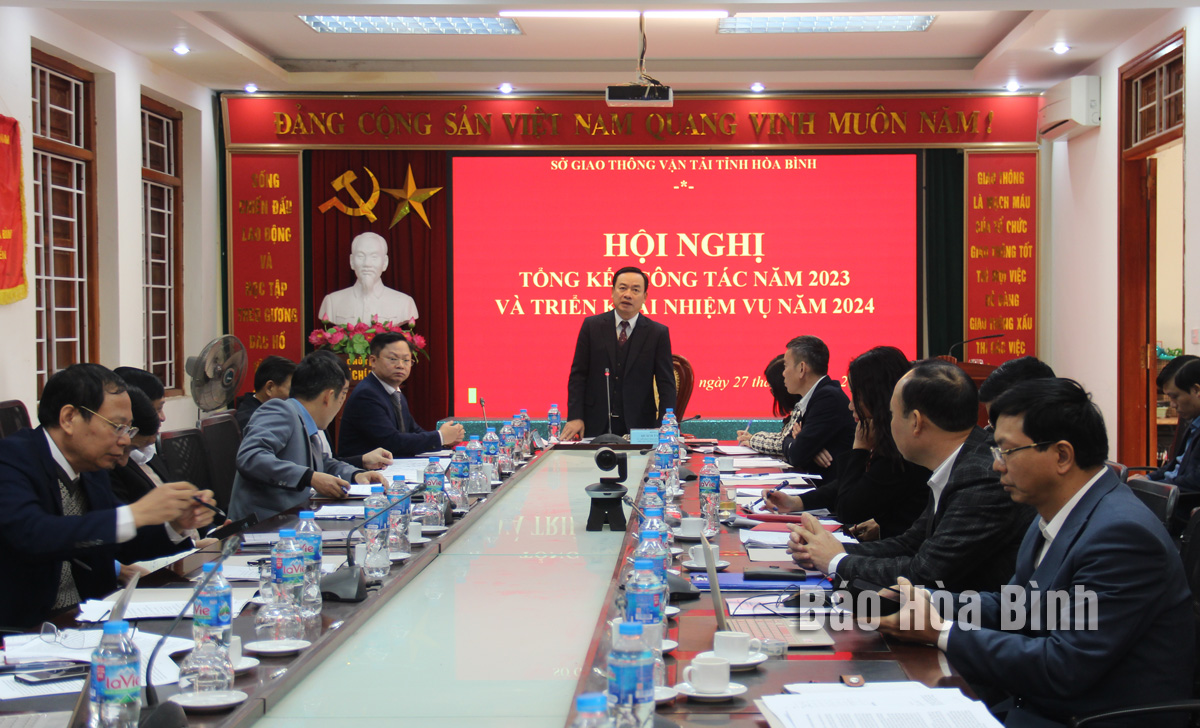
The Department of Transport of Hoa Binh province on December 27 hosted a conference to review its performance in 2023 and launch tasks in 2024, in the presence of Vice Chairman of the provincial People’s Committee Quach Tat Liem.
Vice Chairman of the provincial People’s Committee Quach Tat Liem speaks at the conference.
The locality’s transport sector completed its assigned tasks in 2023. It has proactively advised the province, enlisted support of the Government, ministries and sectors, mobilised and attracted capital, and closely coordinated with sectors all levels to invest in a number of important projects for the province’s socio-economic development, including the Hoa Binh – Moc Chau expressway (Km19+000 – Km53+000); the inter-regional road project Hoa Binh - Hanoi, and the Son La highway.
The sector also continued to invest in four traffic projects and 41 projects to repair roads in the locality. The planning work, and relevant mechanisms and policies were implemented promptly and effectively with many concerted solutions being taken in managing traffic infrastructure facilities.
Attention was paid to the implementation of the province's medium-term public investment plan, a project to concretise rural roads during the 2021-2025 period, and a project to regularly maintain the road systems in the locality in 2022-2025.
Efforts were promoted to ensure traffic order and safety, and smooth transport of goods and passengers, thus serving production and business activities in the locality.
Addressing the conference, Vice Chairman of the provincial People’s Committee Quach Tat Liem urged the transport sector to continue measures to address difficulties in site clearance, mobilise resources for constructing transport infrastructure, boost vehicle registration, and ensure traffic order and safety. He asked relevant departments and sectors to coordinate with the transport sector in allocating capital sources, appraising traffic works, and accelerating site clearance to serve the construction of traffic projects in the province.
Hoa Binh province is undergoing a dynamic transformation amid Vietnam’s national digital transition. Building on Poliburo’s Resolution No. 57-NQ/TW on breakthroughs in science, technology, innovation, and national digital transformation, the province has rolled out a wide range of practical action plans. A standout initiative is the "Digital Literacy for All” movement, an effort to ensure that no one is left behind in the digital era.
Hoa Binh province is undergoing a dynamic transformation in the wake of the national digital transformation movement. Building on Resolution No. 57-NQ/TW of the Politburo on breakthroughs in science, technology, innovation, and national digital transformation, the province has implemented a wide range of practical action plans. A standout initiative is the "Digital Literacy for All” movement ambitious effort to ensure that no one is left behind in the digital age.
With a spirit of unity and proactive problem-solving, the Party Committee, the government and the people of Dong Lai Commune (Tan Lac District) have made great strides in implementing the resolutions of the 24th Party Congress of the commune for the 2020 - 2025 term. Focusing on leadership and practical actions, the commune has brought the Party’s resolutions into daily life, creating strong impacts and pushing the local development forward.
Amid the nationwide push for digital transformation, young people in Hoa Binh Province are stepping up as dynamic pioneers, applying technology to enhance Youth Union operations and expand the reach of youth-led initiatives. Through creativity and adaptability, Youth Union organizations at all levels have introduced a series of practical solutions, contributing to modern governance and community development.
In recent years, An Nghia commune, located in Lac Son district, has stepped up administrative reform, focusing on improving the quality and efficiency of its single-window service unit for receiving and processing administrative procedures. These improvements have helped create favourable conditions for local residents and organisations to handle administrative procedures, contributing to the commune’s broader socio-economic development.
The Prime Minister-approved master plan to develop the multi-use value of forests ecosystems through 2030, with a vision to 2050, aims to improve the management and sustainable use of forest resources, create jobs, increase incomes, and improve the living standards of ethnic minorities, people in mountainous and remote areas, forest workers and those living near forests.



